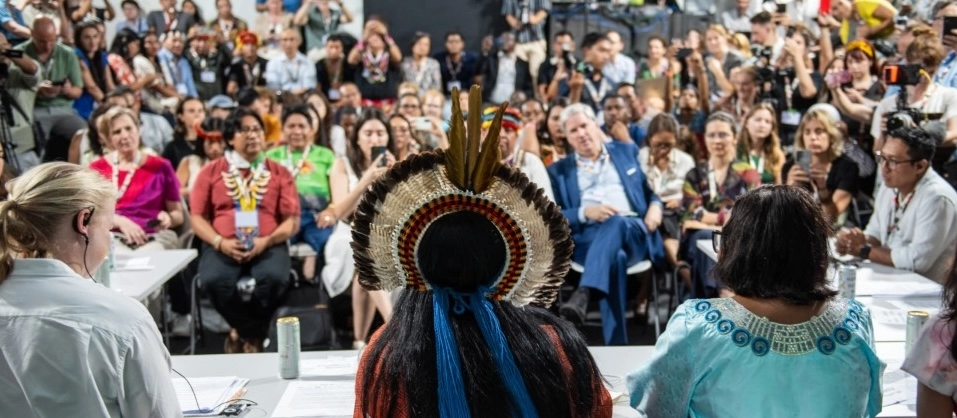Lessons from Climate Week NYC: what’s next for COP30?

This year’s Climate Week NYC, themed “Power On,” marked a decisive shift in tone and focus. The conversations were less about lofty pledges and more about delivery, getting real about risk, finance, and proof of progress.
As the dust settles, Climate Week 2025 made one thing clear: the climate movement is shifting from ambition to accountability. Across packed rooms and side events, the message was that the next stage of climate action has to be faster, fairer, and more inclusive.
With the world looking toward COP30 in Belém, Brazil, five core themes emerged that will almost certainly influence the next stage of global climate negotiations and corporate action.
Below we unpack what stood out, why it matters for global climate governance and how leaders in business, finance and policy can act now.
Climate Week NYC 2025: key themes and signals
Adaptation: resilience takes the front seat
Perhaps the most striking change in the discourse this year was the acceptance that overshooting the 1.5°C target is increasingly likely, at least temporarily. That’s not an easy thing to admit, but it’s also made the conversations more honest and practical. Instead of talking only about cutting emissions, people are now talking real courses of action to live with the impacts that are already here. Across panels, from finance to urban planning, speakers emphasised that adaptation can no longer be treated as a secondary concern but, quite literally, as a survival strategy.
Resilience now means more than just building seawalls, cooling cities or reinforcing infrastructure. Conversations at NYCW covered hardening global supply chains, revising building codes and rethinking insurance models as physical climate risks hit harder. Floods, fires and heatwaves are no longer distant possibilities but current liabilities that are already disrupting balance sheets and driving insurers out of high-risk regions.
Heading into COP30, this “pivot to realism” means adaptation will likely get a bigger slice of attention and funding. Countries are likely to push for clearer resilience metrics and ways to measure progress plus easier access to adaptation funds. For companies, it’s a signal that physical climate risk needs to be part of every major business and investment decision. The adaptation era, in short, is no longer about preparing for tomorrow but about staying solvent today.
What does this mean for COP30 communications?
Messaging needs to acknowledge that the age of adaptation is here today. Communications should focus on how your organisation is addressing physical climate risk right now, not just what you’re doing to reduce emissions in the future. Use plain, grounded language to explain how your initiatives are helping communities, infrastructure or operations become more resilient. Prioritise localised, human examples, especially if you work in high-risk geographies or exposed sectors like agrifood, manufacturing or logistics.
- For corporates: position your climate risk strategy as a business continuity plan.
- For NGOs: show how your programmes are supporting frontline adaptation.
- For government agencies: provide visual proof of adaptation outcomes and demonstrator projects rather than purely talking policies.
Finance: still the bottleneck, but the market is moving
The toughest question in climate action is still “who pays?” While public funding remains slow and uneven, the private sector is starting to fill the gap, at least where clean energy and infrastructure projects make business sense. Investors are putting more money into renewables, battery storage and grids, especially in markets where the economics already work. But money (or the lack of it) remains the single biggest constraint to climate progress.
Yet the financial conversations at Climate Week this year were more dynamic. The big challenge is getting capital to flow where it’s needed most: developing countries, local projects and early-stage ideas. That’s why blended finance (the mix of public and private money) came up again and again at Climate Week. It’s one of the few ways to make riskier projects investable. At the same time, finance leaders are paying much closer attention to physical risks, like where factories, farms and offices are located – plus how vulnerable they are to extreme weather. Some investors are even using satellite data to guide decisions.
As we know from our work with the Integrity Council for the Voluntary Carbon Market, carbon markets were another hot topic and maturing fast. Governments and investors are starting to agree on clearer rules and standards, which could help unlock a new wave of climate funding.
For COP30, expect a strong push to finalise global rules for carbon trading, simplify access to clean energy finance and build the infrastructure needed to power everything, including the growing energy demand from artificial intelligence. Many speakers pointed out that AI’s exploding electricity use is now a climate issue too.
So what does this mean for communications at COP30?
This is a moment to reframe finance stories around access and impact, not just scale. Policymakers and investors alike are looking for signals that capital is flowing to where it’s most needed. If you’re working on blended finance models, early-stage clean tech or local infrastructure projects, your narrative should centre on demonstrable progress. Highlight real-world examples that show how your funding models reduce risk and unlock climate action.
And do not ignore AI: if your organisation is investing in tech, power or data infrastructure, speak to the energy implications of AI head-on.
- Use communications to demystify financial tools like carbon markets or blended finance.
- Translate financial impact into community outcomes, like access to energy or flood protection.
Use infographics to show where capital is going – and where it’s not.
Climate finance justice: making access fairer, faster and more inclusive
A message that came through clearly this year was that promising money isn’t enough.The system for getting funds to where they’re needed still doesn’t work properly. Many smaller or more vulnerable countries to climate change can’t access the climate finance that’s supposedly available to them. The process is often slow, full of red tape and heavily skewed toward big players.
The refrain across countless panels was that promises are not impact. Speakers and activists called for a finance system that’s fairer, simpler and more inclusive. Climate finance must not only grow but also reach those who need it most. They pushed for “results-based finance,” meaning funds should be tied to real progress on the ground, like trees planted, hectares of mangroves restored, homes protected from flooding, or renewable energy built, instead of vague promises.
They also warned against loans or conditions that increase debt for developing countries. Instead, the focus should be on partnership and empowerment. The idea is that finance should enable resilience and avoid creating higher dependency.
At COP30, expect a stronger conversation about who pays, how the money is delivered, and how to make it easier for small economies and communities to actually use it. This conversation will likely crystallise into calls for a restructured global finance framework, one that simplifies access, cuts red tape, and channels resources to the local level. For businesses, this means thinking about how to build projects that create real impact locally, not just investments that look good on paper.
So what does this mean for communications at COP30?
Storytelling around finance needs to centre on equity and empowerment. Language like “unlocking finance” or “mobilising billions” is no longer enough. COP30 audiences, especially those from the Global South, want transparency, dignity and action. Your comms strategy should elevate stories from communities who are actively using climate finance to drive measurable results. If you’re working with or funding local projects, your role is to spotlight them, not speak for them.
Avoid donor-centric framing. Instead, demonstrate how finance is being co-designed and co-delivered with local actors.
- Showcase partnerships, not just funding commitments.
- Elevate diverse voices using community-led case studies.
- Include visuals that reflect real people and real places, not stock imagery.
Data and tangible progress: from promises to proof
Another big takeaway from Climate Week was accountability. The time for making promises has passed. What matters now is proof. Simon Stiell, Executive Secretary of the UNFCCC, put it bluntly: “The test now is delivery.”
This is a clear signal to both governments and companies. Announcing targets is no longer enough. What counts is showing results, real progress that can be measured and verified. Countries will be expected to report more clearly on how much they’ve actually achieved, not just what they plan to do. Both governments and corporations alike are being asked to demonstrate tangible progress, measured not in dollars announced or targets declared, but in megawatts installed, emissions reduced and lives protected.
This shift will likely shape how COP30 is organised. We can expect more attention on reporting, tracking and delivery frameworks. For companies, this means it’s time to move from pilots and pledges to visible, verifiable outcomes. Investors and regulators are asking for data. The organisations that can show tangible results will gain trust and attract capital. Those who can’t will struggle to stay credible.
So what does this mean for communications at COP30?
Now is the time to show your evidence. COP30 will reward those who come with data not just declarations. For your communications strategy, that means tightening your metrics, cleaning up your reporting language and ensuring your climate claims are evidence-based. Think: megawatts deployed, emissions reduced, hectares restored, not just “ambitious goals.” Align your messaging with credible frameworks like NDCs, SBTN or CDP so you can show what you’re achieving accurately and transparently.
If you’re not yet at full transparency, say so—owning the journey can build trust.
- Invest in content formats that visualise impact clearly with infographics, digital dashboards and charts
- Build trust by sharing both achievements and gaps
- Use third-party validation and partnerships to reinforce credibility
Nature and food systems: zooming into focus
One of the most exciting developments this year was the rise of nature and food systems as central parts of the climate story. For a long time, protecting nature was seen as separate from climate action. Now it’s clear they’re deeply connected and synergistic. Agriculture, forests and biodiversity are at the heart of both the problem and the solution.
A highlight of the week was the launch of the Forest Finance Roadmap for Action, supported by 34 governments and led by Brazil. It outlined six major ways to close the forest finance gap, from scaling up programmes that reward countries for reducing deforestation, to launching a new fund called the Tropical Forests Forever Facility (TFFF). The idea behind TFFF is powerful: create an endowment-style fund that pays out steady, long-term rewards to countries that keep their forests standing.
This could be a defining topic at COP30, which will take place in the Amazon region itself. Brazil wants to make forest finance one of the central outcomes of the conference and many countries and investors seem ready to back that goal.
For companies, this growing focus on nature means change is coming fast. Businesses in food, fashion and consumer goods are under pressure to prove their supply chains are free from deforestation and nature loss. More importantly, protecting nature is now being seen not just as a moral duty, but as a financial opportunity. Healthy forests, soils and ecosystems are the foundation for resilient economies and supply chains. Building nature into business strategies is becoming recognised as simply smart business.
So what does this mean for communications at COP30?
COP30 will be the first hosted in the Amazon. Nature will not be a side event. It will be centre stage. Comms teams must elevate the role of forests, food systems and biodiversity in climate solutions. If your organisation touches land use, agriculture, supply chains or restoration, your messages should connect nature to business risk and opportunity. Go beyond compliance: how are you actively protecting or restoring nature?
For brands in food, fashion or consumer goods: nature-positive claims must be backed by traceability, transparency, and tangible outcomes.
- Frame nature as infrastructure that is foundational to business resilience and economic stability
- Prioritise stories from Indigenous Peoples and local communities, especially in Amazonian contexts.
- Prepare to show how your supply chain or operations align with forest finance goals.
Organisation and policy implications: what it means for COP30
Taken together, these themes point to a world where credibility, equity and delivery define climate leadership. For global governance, COP30 will likely focus on three intertwined goals: scaling finance, deepening accountability and embedding justice into every climate mechanism.
For the private sector, the implications are equally clear. Investors and companies will be expected to:
- Integrate adaptation and resilience into financial risk assessments
- Align investment portfolios with credible, transparent carbon accounting
- Demonstrate community-level impact, especially in developing regions
- Ensure supply chains and disclosures reflect real-world outcomes, not just targets
Businesses that can show results, prove integrity and build trust across their ecosystems will be the ones shaping (not following) the next decade of climate policy.
Preparing for COP30: what communication leaders can do now
For sustainability officers, communications leads and policy teams, now is the time to get ahead of the conversation.
- Audit your credibility. Review how your organisation reports climate progress. Are your metrics clear, auditable, and aligned with global standards?
- Map your finance story. Whether you’re a corporate, investor or NGO, clarify how your funding or investments are improving access, fairness, and delivery. Show real impact on the ground.
- Engage locally. The strongest climate stories now come from projects that show visible, measurable benefits for communities.
- Build your COP30 narrative. Think beyond targets and promises. Focus on what proof points you can share in Belém that demonstrate real delivery.
Final reflections: the moment for decisive action
Climate Week NYC 2025 has shown that the climate movement has matured. The conversations are no longer about distant goals but about the practical, sometimes messy, but absolutely necessary work of implementation.
Adaptation is no longer optional. Finance is starting to flow, but it must be fair and faster. Promises are being replaced by proof. And nature, long the missing piece, is finally being treated as the living infrastructure it truly is.
As we move toward COP30, the challenge is to make all of this real. Rapid, fair implementation is everything. The ideas are there. The technology exists. The capital is starting to move. What matters now is delivering this transition and building a future (and a present) that actually works.



